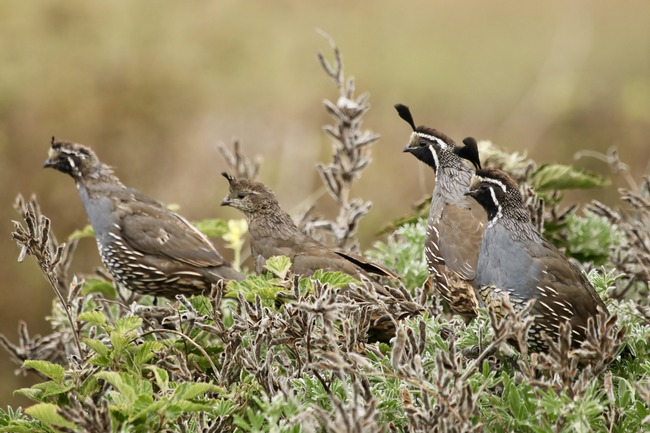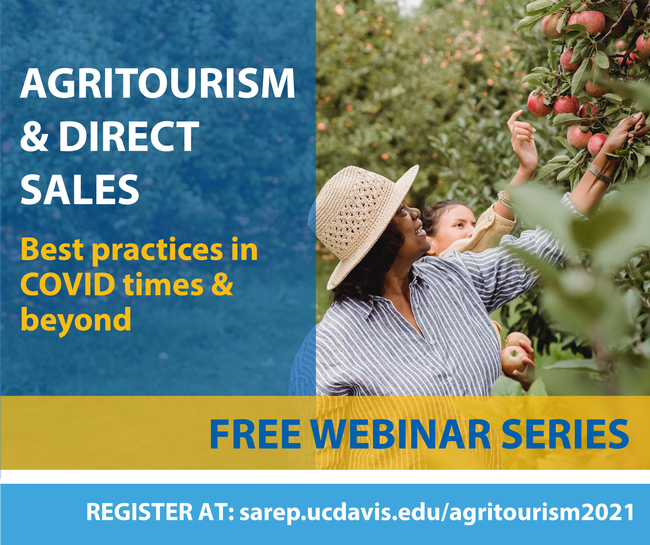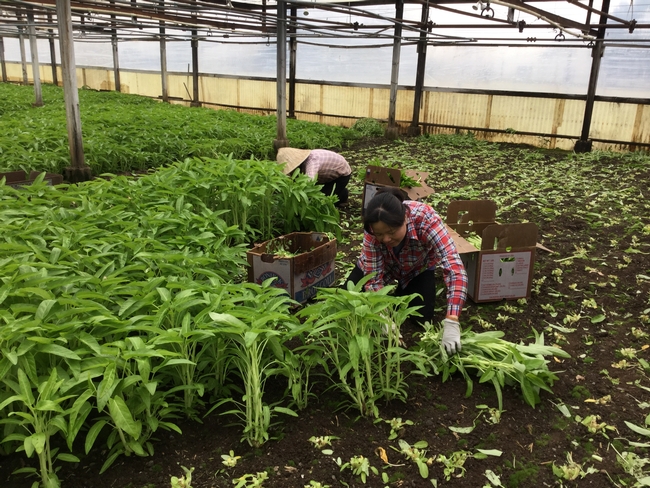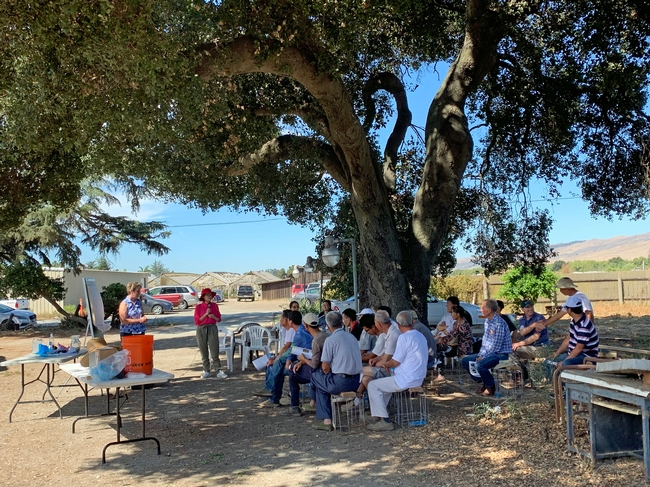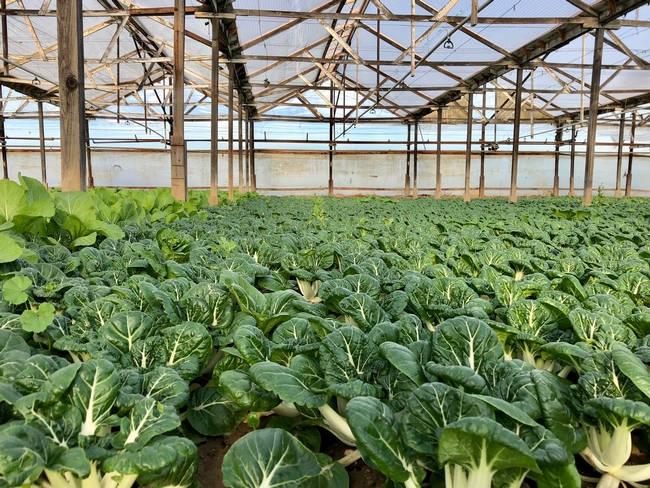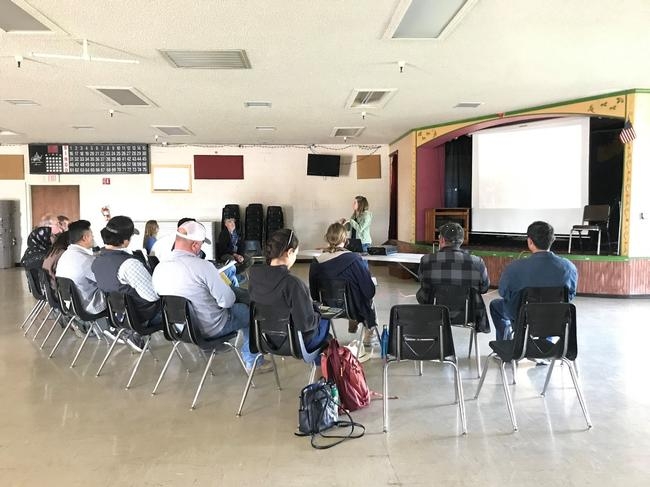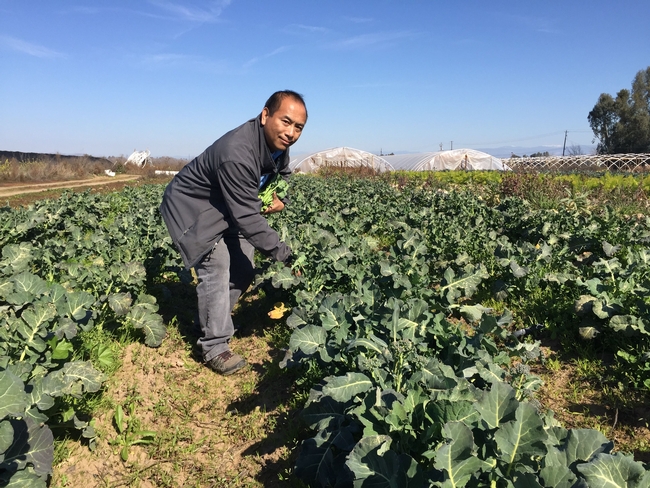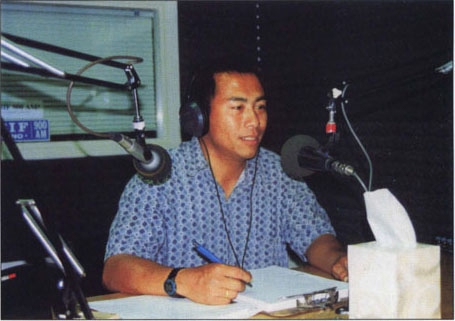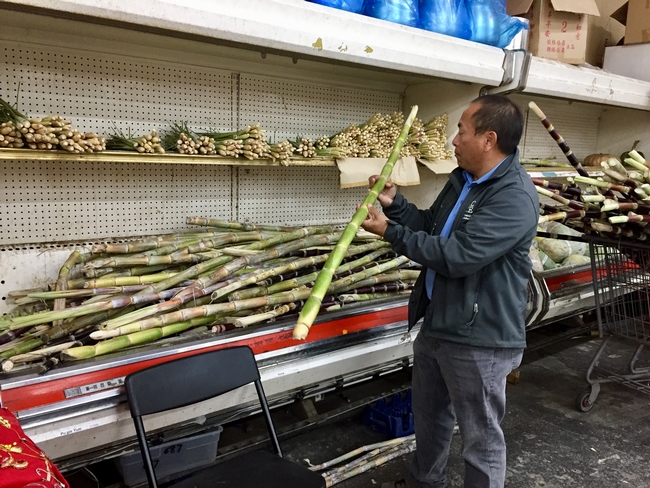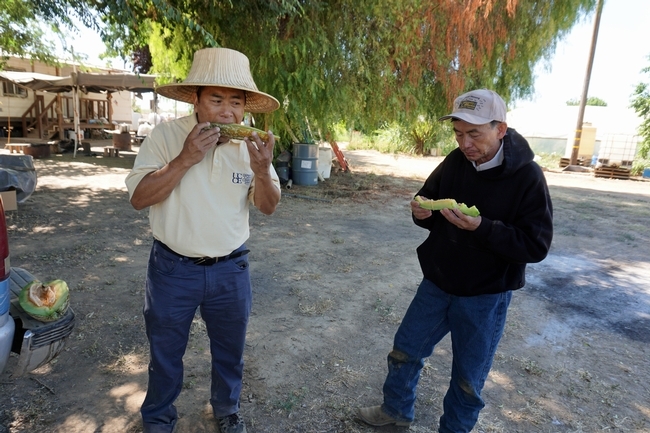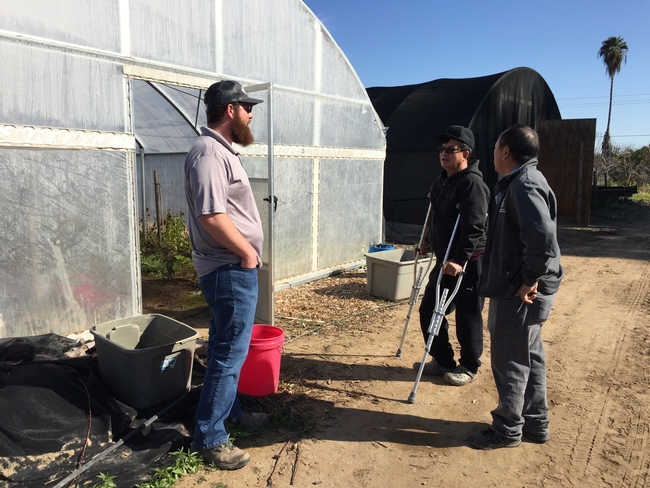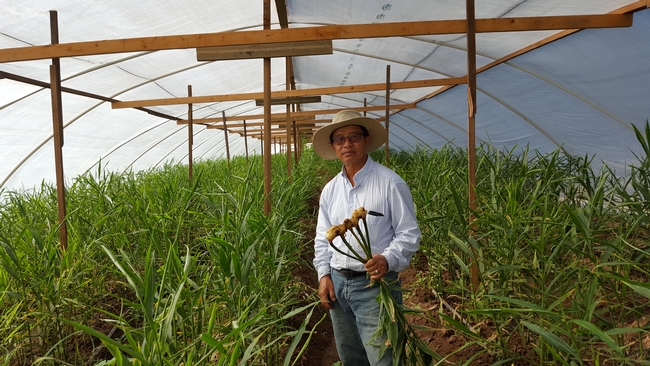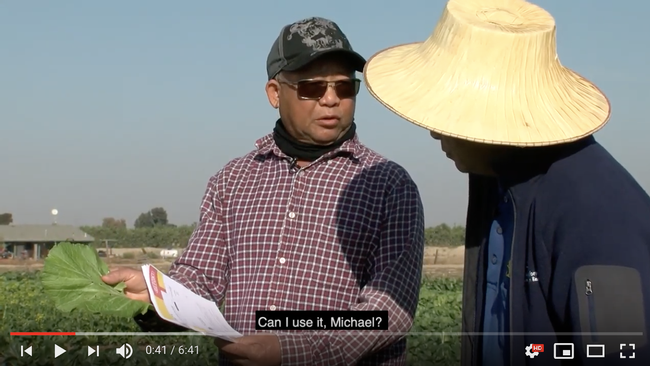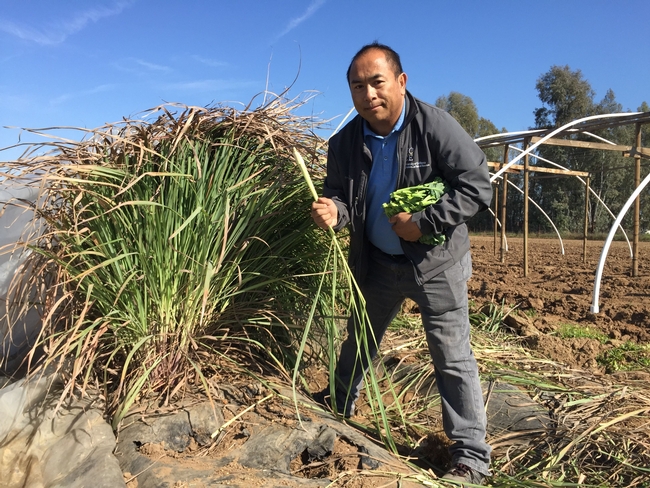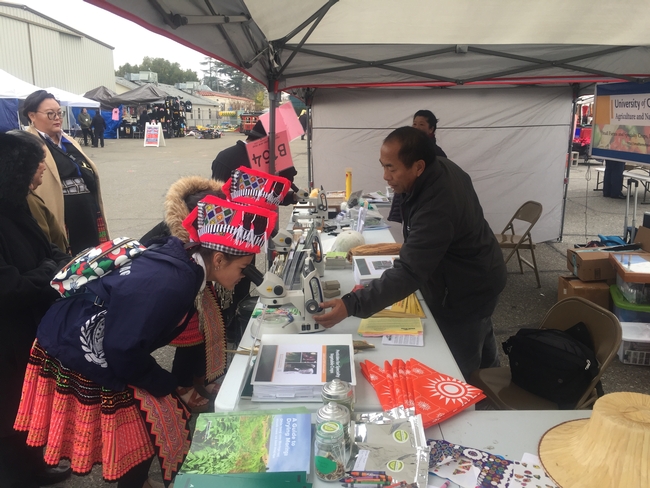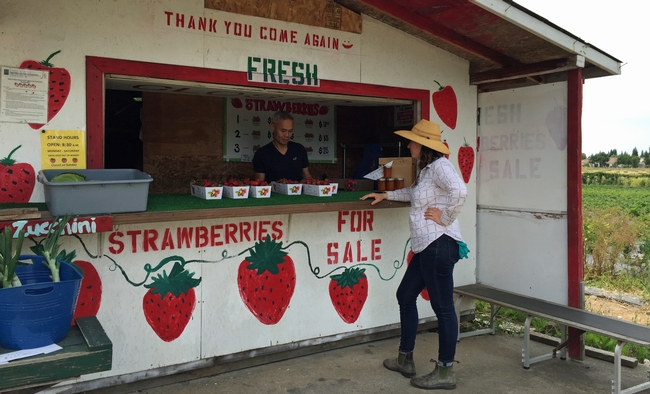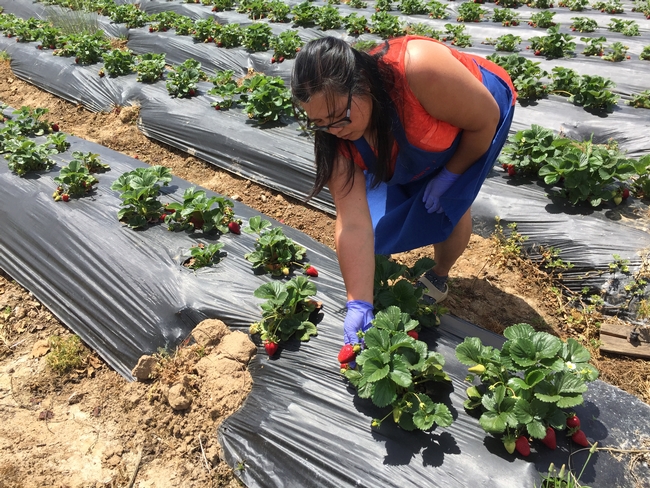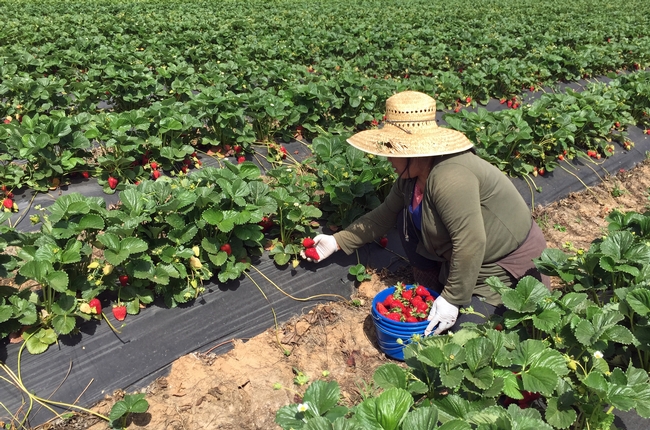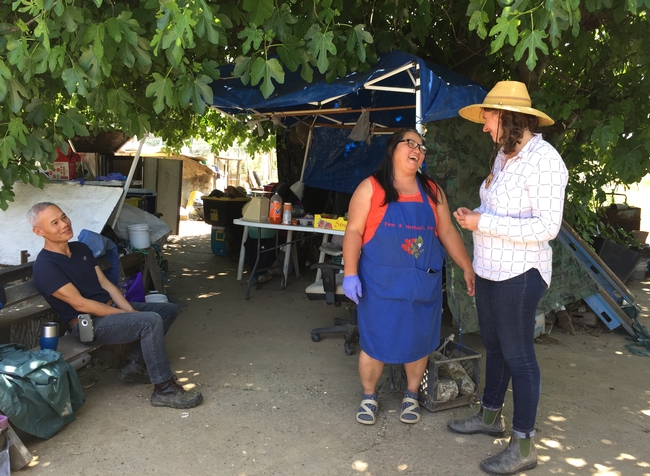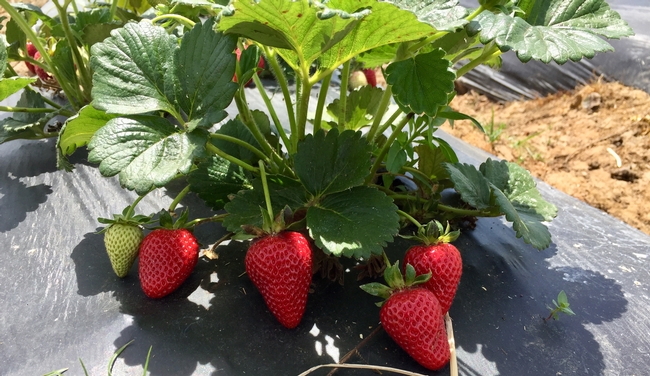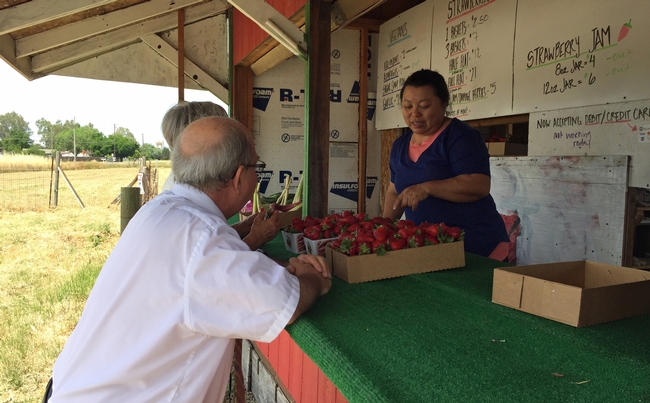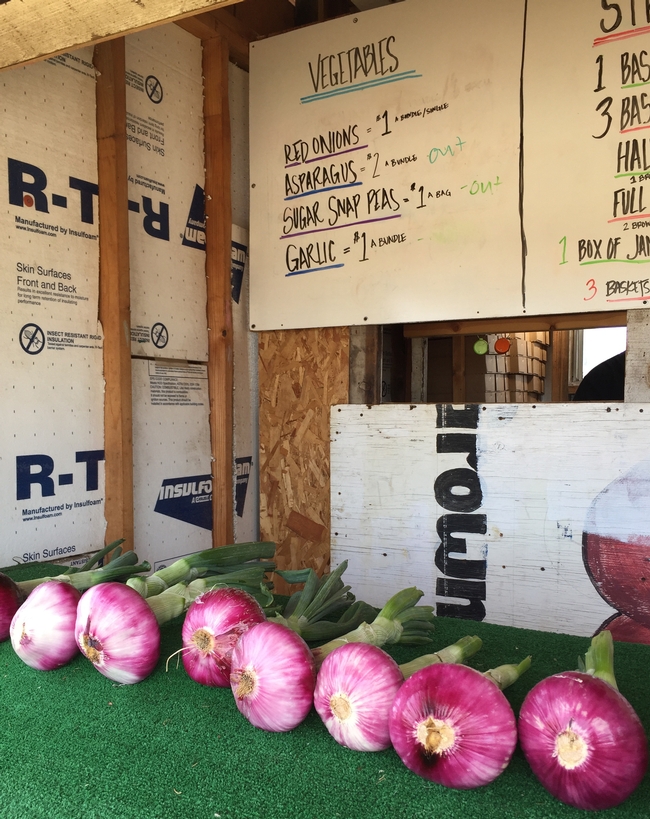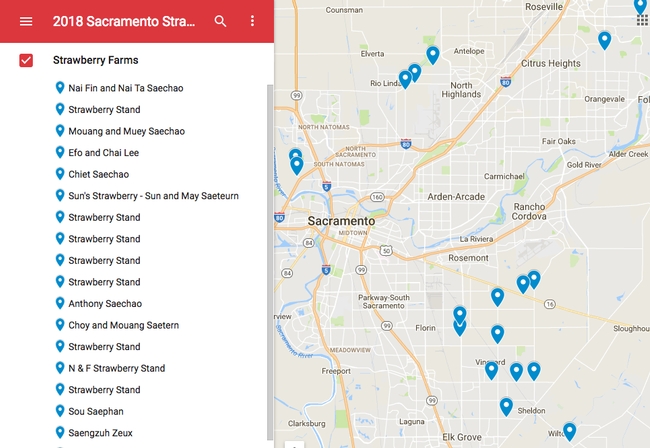Posts Tagged: farms
Bringing out the best in wild birds on farms
Natural habitat maximizes the benefits of birds for farmers, food safety and conservation
A supportive environment can bring out the best in an individual — even for a bird.
After an E.coli outbreak in 2006 devastated the spinach industry, farmers were pressured to remove natural habitat to keep wildlife — and the foodborne pathogens they can sometimes carry — from visiting crops. A study published today from the University of California, Davis, shows that farms with surrounding natural habitat experience the most benefits from birds, including less crop damage and lower food-safety risks.
The study, published in the Journal of Applied Ecology, was conducted at 21 strawberry fields along California's Central Coast. It found that birds were more likely to carry pathogens and eat berries without surrounding natural habitat.
The authors said a better understanding of the interplay of farming practices, the landscape, and the roles birds play in ecosystems can help growers make the most out of wild birds near their fields.
“Bird communities respond to changes in the landscape,” said lead author Elissa Olimpi, a postdoctoral scholar in the UC Davis Department of Wildlife, Fish and Conservation Biology at the time of the study. “As birds shift in response to management, so do the costs and benefits they provide.”
The single most important driver
The study looked at how different farming practices influenced the costs and benefits that wild birds provided on the strawberry farms. The scientists combined nearly 300 bird surveys and the molecular analyses of more than 1,000 fecal samples from 55 bird species to determine which birds ate pests, beneficial insects and crops, and carried foodborne pathogens.
They also ranked birds to see which were more likely to bring benefits or costs to farmlands. Barn swallows, for instance, got a “gold star” in the study, Olimpi said. Their mud nests are commonly seen clinging to the underside of barn eaves, from which they fly out to swoop over fields, foraging on insects.
But rather than resulting in a list of “good” and “bad” birds, the study found that most bird species brought both costs and benefits to farms, depending on how the landscape was managed.
The presence of natural habitat was the single most important driver differentiating a farm where wild birds brought more benefits than harm.
“Nature is messy, and birds are complex,” Olimpi said. “The best we can do is understand how to take advantage of the benefits while reducing the harms. Growers will tell you it's impossible to keep birds off your farm — you can't do that and don't want to from a conservation perspective. So how can we take advantage of the services birds provide?”
Win-wins for birds and farms
The study is one of several publications from UC Davis Professor Daniel Karp's lab highlighting the environmental, agricultural, and food safety impacts of conserving bird habitat around farms. A related study in 2020 found that farms with natural habitat attracted more insect-eating birds — and fewer strawberry-eating birds — so that farmers experience less berry damage on farms with more habitat nearby. Such habitats also bring greater numbers of bird species to the landscape.
“All together, these studies suggest that farming landscapes with natural habitat tend to be good for conservation, farmers, and public health,” said Karp.
Additional co-authors of this study include Karina Garcia and David Gonthier of University of Kentucky, Claire Kremen of UC Berkeley and the University of British Columbia, William E. Snyder of University of Georgia, and Erin Wilson-Rankin of UC Riverside.
The research was funded by the USDA and UC Davis Department of Wildlife, Fish and Conservation Biology.
UC ANR offers free online trainings on direct sales and agritourism
The economic shocks brought on by the COVID-19 pandemic have pushed California's farmers and ranchers to quickly embrace new business practices — including creative new ways to sell directly to consumers. UC ANR and partners are offering an eight-part series of free virtual trainings to help producers build their businesses with agritourism and other direct-to-consumer sales.
The COVID-19 pandemic has been a huge shock to California's food economy, forcing many of the state's growers to embrace new business practices and drop old ones as “shelter-in-place” directives rolled across the state.
But the pandemic's challenges bring new opportunities too. Consumers' interest in local food and local outdoor experiences has grown immensely, from community-supported agriculture (CSA) and other online ordering, delivery and on-farm pickup options, to visits to farm stands, U-pick operations and other family-friendly socially distanced outdoor activities.
Pivoting to these new marketing channels opens new revenue opportunities for farmers and ranchers across California and the nation. But each new marketing channel also demands new skills and connections.
To help build growers' skills to embrace these market channels, the University of California Sustainable Agriculture Research and Education Program (UC SAREP) at UC Agriculture and Natural Resources is partnering with the Community Alliance of Family Farmers (CAFF) and expert growers across California to offer the free webinar series Agritourism and Direct Sales: Best practices in COVID times and beyond.
Through eight one-hour virtual trainings held this spring, participants will learn about best practices for implementing a variety of direct-to-consumer sales approaches. These trainings are offered to anyone interested in learning more about direct-to-consumer sales and agritourism. Topics and dates are:
| Getting started with community supported agriculture |
Tuesday February 23, 11am–12pm PST |
| Best practices for U-pick operations | Monday March 8, 3-4pm PST |
| Operating a safe, healthy and successful farm stand | Monday March 22, 3-4pm PST |
| Best practices for visitor interaction with animals | Monday April 5, 3-4pm PST |
| Best practices for farm tours, workshops and farm-based education | Monday April 19, 3-4pm PST |
| Online sales options and methods | Monday May 3, 3-4pm PST |
| Creative marketing and staying connected with social media | Monday May 17, 3-4pm PST |
| Community collaboration – farm trails, tourism partners and more | Monday May 24, 3-4pm PST |
Register at sarep.ucdavis.edu/agritourism2021.
For more information:
Penny Leff, UC SAREP, paleff@ucanr.edu, 530.902.9763 (cell)
Funding for this webinar series was made possible by the U.S. Department of Agriculture's (USDA) Agricultural Marketing Service through grant #AM200100XXXXG177. Its contents are solely the responsibility of the authors and do not necessarily represent the official views of the USDA.
UCCE small farms advisor strives to make farming more inclusive and equitable
This is one of a series of stories featuring a sampling of UC ANR academics whose work exemplifies the public value UC ANR brings to California.
The coronavirus pandemic has disrupted life for everyone, with information about COVID-19 changing daily. For Californians who aren't fluent in English, obtaining reliable information is particularly difficult. Aparna Gazula, a University of California Cooperative Extension advisor who serves Santa Clara, San Benito and Santa Cruz counties, has been providing COVID-19-related information in Chinese and Spanish for immigrant Bay Area farmers.
In March, when restaurants shut down to curb the spread of the virus, many restaurants and wholesale produce markets cancelled produce orders placed with farmers. Language, cultural differences, low computer literacy and limited access to computers created barriers for small-scale, immigrant farmers in the Bay Area to quickly find new buyers for their perishable produce. Gazula introduced them to food banks, hoping they would accept the produce donations, but the food banks were not set up to pick up donations from small farmers.
Most small-scale farmers lack the financial capital to absorb the revenue shock. To help offset losses from unsold specialty crops, the UCCE advisor and Qi Zhou, the small farm program assistant specialist, have been helping Asian and Latino farmers complete English-language disaster aid applications.
“Since March, we have helped farmers apply for Covid-19-related farmer relief funds,” Gazula said. So far, she said, four of the 17 immigrant farmers who applied to the American Farmland Trust Farmer Relief Fund have received a total of $4,000, and 10 farmers of the 30 who applied to the California Family Farmer Emergency Fund received a total of $42,500.
Recently the U.S. Department of Agriculture expanded the list of specialty crops eligible for its Coronavirus Food Assistance Program to include bok choy, daikon and other vegetables with a deadline of Sept. 11. Communicating by phone and the app We Chat, Gazula and Zhou, who speaks Mandarin, notified local farmers, and advised them how to apply for the disaster funds. Zhou, USDA Natural Resources Conservation Service rangeland management specialist Ling He and another NRCS staff member assisted 64 farmers in completing applications over the past week.
Bob Kuang, president of the Bay Area Chinese Growers Association, shares UCCE information with the association's growers.
“Most of my members don't understand English so they [UC Cooperative Extension] help, like for policy and safety,” Kuang said, "providing information the growers can't find elsewhere in Chinese.”
When she was a girl, Gazula saw how hard farmers work to make a living off the land while spending summers and winter breaks at her grandparents' farm in India, where they grew rice, mung beans and chili peppers.
“Farmers are very hardworking people, and small farmers even more so as they manage everything on the farm,” said the small farms and specialty crops advisor. “Their grit, determination to succeed and hardworking spirit truly inspire me.”
“I'd like to help them be successful as much as I can,” she said, “be it research-based information to farm successfully or bilingual support to help them better navigate regulations or apply for grant funds.”
In addition to helping farmers apply for financial relief, Gazula alerted the farmers to shelter in place rules and is delivering COVID-19 safety information about masks, sanitation and social distancing requirements in Chinese and Spanish to them.
“We also helped farmers implement COVID-19-related protocols on their farms,” she said. “We are currently putting together 200 COVID-19 kits that will help farmers comply with worker health and safety-related protocols on their farms. The COVID-19 kits contain reusable masks, hand sanitizer, bilingual Cal OSHA guidelines for employers regarding COVID-19, and a resources sheet listing where to buy the enclosed items.”
When she's not involved in COVID-19 crisis communications, Gazula continues to conduct research on nitrogen uptake in bok choy and bell peppers and irrigation management. She collaborates with Linda Chu, Guo Ping Yuan, Han Qiang Kuang and other Santa Clara County growers who allow the farm advisor to study crops on their farms.
“They do research, like test irrigation systems for right amount of water for the crop and nutrition – fertilizer – for the crop. They do lot of things,” said Kuang, of the Bay Area Chinese Growers Association, who provides land at his farm in Gilroy for UCCE studies.
Gazula also advises farmers on how to implement the Food Safety Modernization Act (FSMA) on their farms and fulfill irrigated land nitrogen reporting. Fines for not complying with regulations can threaten the economic sustainability of small family farms.
Although the majority of growers she works with regularly have limited English and need assistance filing reports to the government, others consult her for production information they can't get elsewhere for the specialty crops they grow. Farmers of Korean, Japanese, Indian and Vietnamese ancestry and others attend meetings to learn the latest research on Asian vegetables such as daikon radish, napa cabbage, bok choy, on choy and various Asian leafy mustard crops including gai choy and pea shoots.
Gazula, who joined UC Cooperative Extension in 2016, currently works with about 180 small-scale growers in San Benito and Santa Clara counties and hopes to expand her outreach to farmers in Santa Cruz County.
To help small farmers adapt to climate change, Gazula and Zhou partnered with UC Agriculture and Natural Resources' Healthy Soils Program staff and Santa Clara County Farm Bureau for technical assistance and held workshops during the winter. Zhou helped the farmers apply for grants from the California Department of Food and Agriculture's State Water Efficiency & Enhancement Program and Healthy Soils Program. The 22 farmers who received CDFA grants brought a total of $424,111 into Santa Clara County.
The outreach work UC Cooperative Extension does wouldn't be possible without the help of bilingual staff such as Zhou, the scientist Gazula hired with grant funds in September, and some translation support from partner organizations and growers as well.
“Relying on partners for translation support isn't practical,” Gazula explained. “Outreach is most effective when it is targeted. It's not just literally translating words, but translating the information the words convey. Because we provide outreach materials to comply with regulations, the language in these materials is very technical and it's important that the information is presented accurately. We also depend on relationships with the farmers to extend the information within their communities. Long-term, it's easier to do outreach with support from our own staff.”
Competition is stiff for money to serve non-English-speaking Californians because the state is home to so many immigrants with different needs. The majority of the grants she uses for outreach are for food safety. The local Open Space Authority, which promotes preserving land for open spaces, has also provided funds for small and beginning farmer outreach and education.
Gazula draws on the expertise of fellow UC Cooperative Extension farm advisors across the state. For example, she said, Richard Smith, who specializes in vegetable production, and Michael Cahn, who specializes in irrigation and water resources, are always willing to help, even though they are not assigned to serve Santa Clara County.
“Farmers already have tremendous challenges when it comes to being successful,” Gazula said. “I feel language barriers and lack of access to the same resources as fluent English-speaking growers shouldn't be the reason they can't farm successfully.”
In person and over the airwaves, Yang strives to help Hmong farmers prosper
This is the third in a series featuring a few scientists whose work exemplifies UC ANR's public value for California.
Keeping current on government regulations, agricultural marketing news and crop research advances can be challenging for California farmers, especially for those who speak English as a second language.
Hmong farmers in the San Joaquin Valley can tune in at 2 p.m. on Tuesday afternoons to listen to farm-related news delivered to their radios in their native language from Michael Yang, UC Cooperative Extension small farms and specialty crops agricultural assistant for Fresno County.
For the past 22 years, Yang has hosted the one-hour Hmong Agriculture Radio Show on KBIF 900 AM in Fresno to promote prosperity in the largely immigrant, small-scale Southeast Asian farming community. Yang provides advice on crop production and marketing.
“Fresno County has a large number of small and diversified farms; we have over 1,300 Southeast Asian farms and over 900 are Hmong farmers, according to a survey we did in 2007,” Yang said. “I used to help 250 to 300 farmers every year, in the past couple of years it's grown to about 400 farmers.”
Yang not only speaks their language, he shares their culture and history. After his father was killed for assisting the U.S. during the Vietnam War, Yang, his mother and three younger brothers spent 4 years of his childhood fleeing on foot through the jungles of Laos, subsisting on vegetation and wildlife, to reach safety in Thailand. The refugee family eventually made it to Fresno, where they took up farming.
The Hmong farmers grow Asian specialty crops including eggplant, lemongrass, long bean, squashes, bittermelon and moringa that they sell at farmers markets or to restaurants. Connecting Southeast Asian farmers to sell their produce at farmers markets has been a vital role for Yang, who serves as a translator and cultural interpreter between the immigrant farmers and farmers market managers. He explains the requirements for participating in the farmers markets and helps the farmers with paperwork and communication. Some growers drive as far as San Diego to get a higher price for their produce; the price can be three times as high at farmers markets in larger cities compared to Fresno.
Sales of Asian specialty crops grown by Hmong and other Southeast Asian farmers in Fresno County are valued at about $17.5 million annually, according to the Agricultural Commissioner of Fresno County.
Although Yang and colleague Ruth Dahlquist-Willard, UC Cooperative Extension small farms advisor, offer workshops and field days to share information, the radio show is an important information source because farmers can listen to the show while they work in the field. Because Hmong Agriculture Radio Show is such a critical tool for bilingual outreach, Dahlquist-Willard continually seeks grants to pay the $75 per show to the radio station. Of the 69 Hmong farmers who responded to a 2015 UC Cooperative Extension survey, 80% said they regularly listened to Yang's radio show.
“With the help of our Hmong Agricultural radio outreach, I have Hmong farmers calling our office for assistance from Tulare County up to Stanislaus County,” Yang said.
In 2015, during the drought, Yang and Dahlquist-Willard began helping desperate farmers who were running out of irrigation water.
“Wells were starting to dry up. Some Hmong farmers were reportedly calling suicide hotlines,” Dahlquist-Willard recalled. “For the ones with dry wells, it could cost $20,000 to $50,000 to drill a new well.” That is money that most of the farmers, who typically cultivate less than 50 acres, didn't have.
Eighty-seven percent of the Hmong farmers said their utility bills had risen during the drought. Yang, Dahlquist-Willard and Xai Chang, a young Hmong farmer working with UCCE, helped the farmers get a free PG&E rate analysis, which could help the farmers choose the best electric rate for their irrigation practices to lower the expense. The UCCE team also searched for financing to deepen wells for farmers who had difficulty qualifying for USDA loans and helped them apply for grants from the State Water Efficiency and Enhancement Program. With additional help from small farms assistant Jacob Roberson, the UCCE small farms team in Fresno has assisted 36 small-scale Hmong, Latino, and African-American farmers to implement SWEEP projects on a total of 846 acres. The small-scale growers have used SWEEP dollars to invest in technologies like energy efficient pumps, drip irrigation systems and flow meters to save water and reduce their energy costs.
“Michael helped me get a grant to buy a new pump for drip irrigation,” said Xiong Pao Her, who grows about 100 crops throughout the year – including ginger, broccoli rabe, fennel, garlic, green onions, napa cabbage and kale – in Sanger. “It saves me water.”
Obtaining land to farm can be difficult for small-scale farmers so the UCCE agricultural assistant connects farmers looking to rent land with landowners, and serves as a bridge for the language and cultural gaps between the two, according to Dahlquist-Willard.
“There was an elderly couple and their daughter wanting to rent land to a Hmong family, and Michael sat down at the table with all the parties and helped them work out a lease agreement, such as requirements for liability insurance,” she said. “Land isn't as available to rent as it used to be, but when it was, Michael would get frequent calls from landowners asking if he knew any farmers who would be interested in renting their land. The number of Southeast Asian farmers who have had a successful lease agreement or a successful farmers market stand because of Michael's help is probably very large.”
Recently Yang and Dahlquist-Willard partnered with California State University Fresno to produce a pesticide-safety video series for the California Department of Pesticide Regulation. “We hope the videos help more farmers understand pesticide regulations and avoid fines, as well as improve their safe handling, selection and effectiveness,” said Yang.
It's not the first time Yang, who has been working for UC Cooperative Extension since 1993, has helped farmers navigate government regulations. Between 2005 and 2008, individual Hmong and Hispanic farmers were being fined between $14,000 and $26,000 for noncompliance with state labor regulations. To provide farmers with a clear understanding of the labor laws, Yang and Richard Molinar, then UCCE small farm advisor, partnered with a variety of community organizations to present information to farmers in English, Spanish, Lao and Hmong at community meetings, on the radio and television, and in trade magazines and newspapers.
“Without the support provided by the UCCE, hundreds, if not thousands, of Hmong farmers would have been added to the victim list for not knowing or understanding the laws. The UCCE has gone many extra miles to fill gaps between enforcement agencies and the Hmong farming community,” Toulu Thao, a Hmong activist, said at the time.
To help farmers decide which crops are most profitable to plant, Yang collaborated in the past with UC colleagues to estimate production costs for some Asian vegetables including sinqua, moqua, opo, longbean, bittermelon, oriental eggplant and lemongrass.
Yang currently advises Hmong growers on about 200 crops and continues to learn about new ones as farmers market customers ask the growers to produce fruits and vegetables from other cultures.
Strawberry stands sell berries fresh from the field
Slugs, snails, ants, aphids, spider mites and inclement weather conspire against strawberry growers harvesting perfect red berries to sell.
“Farming is hard work,” said Fam Lee, as she pulled a weed from a row of strawberry plants. Lee and her husband Nathan Punh are among about 60 Mien farmers in the Sacramento area who call on Margaret Lloyd, a UC Cooperative Extension advisor, for farming advice.
“Although we are not organic farmers, we always want to go with organic,” said Lee. “For example, we have slugs and ants, I asked Margaret if it's okay to put organic slug bait around the plant as long as it doesn't touch the berry. She said that's the best way to do. We work closely with our extension staff.”
In the Sacramento area, many of the Mien-owned farms are husband and wife teams. The typical couple farms an acre or two themselves, picking berries to sell the same day at a roadside stand, which provides the family's primary source of income.
“Many of them grew up on farms in Thailand or Laos growing vegetables or growing rice or soybeans,” said Lloyd, who serves small-scale farmers in Sacramento, Solano and Yolo counties. “A lot of them come from farming backgrounds so when they came to this country, they also sought out an agrarian lifestyle.”
Some Mien growers had never seen a strawberry before arriving in California, but chose the high-value crop to maximize returns on their small plots of land.
To help Mien growers develop successful strawberry farms, Lloyd updates them on regulations and shares growing tips at an annual extension meeting, visits them at their farms, and records videos demonstrating how to do things such as using compost to fertilize the crop.
“Because of language barriers, coming out to the farm regularly is a big part of the job,” said Lloyd, who partners with staff from the National Center for Appropriate Technology (NCAT) to assist Mien farmers.
“Once we're on the farm, we can communicate in-person more easily,” she said. “Often times it involves pest identification, so I'll show them how to use a hand lens and how to identify spider mites, aphids and lygus bugs, for example.”
“A lot of them have children who speak English fluently so if they don't speak English fluently, sometimes the children come out and help.”
For the past five years, Lee and Punh have been growing and selling strawberries at a farm stand on Bond Road, between Bader and Bradshaw, in Sacramento. They grow Albion, Chandler, Santa Rosa and Seascape – sweet, delicate varieties, some of which aren't found in supermarkets because the berries don't store and ship as well. They typically begin harvesting berries at the end of March and pick through July or August, depending on the weather. This year, the first berries were ruined by spring rain and frost.
Savvy consumers will ask for certain varieties by name, Lloyd said. “Chandler is well-loved by consumers for its delicate flesh and sweet flavor. Albion produces larger berries that are also very tasty.”
Because berries sold at the roadside stands are picked fresh daily, the farmers wait until berries are perfectly ripe before picking them.
Monday through Saturday, Lee begins harvesting her strawberries by hand at the break of dawn.
“We start at 5:45, the minute we can see, and we pick until 8 o'clock. That's our goal,” Lee said. “By 8:30, we want to open our stand and we sell until all the berries run out.”
Lee's parents often drive up from Alameda to help pick berries.
To extend the farm stand season, some Mien farmers supplement the strawberries with other berries, strawberry jam and vegetables. They grow blueberries and blackberries, tomatoes, peppers and green beans and sometimes specialty vegetables such as bittermelon.
“Growing strawberries isn't easy, but it's enjoyable work,” Lee said.
Lloyd has updated a map showing locations of about 60 strawberry stands in the Sacramento area at http://bit.ly/strawberrystands.


